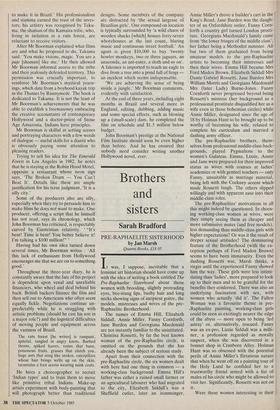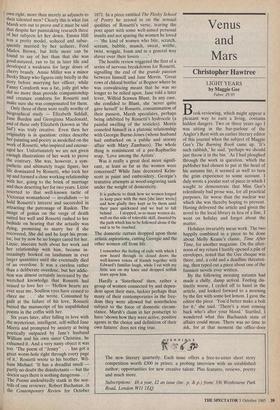Brothers and sisters
Sarah Bradford
PRE-RAPHAELITE SISTERHOOD by Jan Marsh Quartet Books, £18.95
It was, I suppose, inevitable that a feminist art historian should have come up with the idea of writing a book entitled The Pre-Raphaelite Sisterhood about those women with brooding, slightly protruding eyes, bee-stung lips, bushy hair and long necks showing signs of incipient goitre, the models, mistresses and wives of the pre- Raphaelite Brotherhood.
The names of Emma Hill, Elizabeth Siddall, Annie Miller, Fanny Cornforth, Jane Burden and Georgiana Macdonald are not instantly familiar to the uninitiated. Christina Rossetti, by far the best known woman of the pre-Raphaelite circle, is omitted on the grounds that she has already been the subject of serious study.
Apart from their connection with the pre-Raphaelite circle, the six women dealt with here had one thing in common — a working-class background. Emma Hill's father was either a ruined small farmer or an agricultural labourer who had migrated to the city, Elizabeth Siddall's was a Sheffield cutler, later an ironmonger,
Annie Miller's drove a builder's cart in the King's Road, Jane Burden was the daugh- ter of an Oxfordshire ostler, Fanny Corn- forth a country girl turned London prosti- tute. Georgiana Macdonald's family came from 'the lower fringes of the middle class', her father being a Methodist minister. All but two of them graduated from being amateur models to the pre-Raphaelite artists to becoming their mistresses and then their wives. Emma Hill became Mrs Ford Madox Brown, Elizabeth Siddall Mrs Dante Gabriel Rossetti, Jane Burden Mrs William Morris and Georgiana Macdonald Mrs (later Lady) Burne-Jones. Fanny Cornforth never progressed beyond being Rossetti's mistress (her background as a professional prostitute disqualified her as a wife even in those bohemian circles) while Annie Miller, designated since the age of 18 by Holman Hunt to be brought up to be worthy of becoming his wife, refused to complete his curriculum and married a dashing army officer.
The pre-Raphaelite brothers, them- selves from professional middle-class back- grounds, played Pygmalions to the women's Galateas. Emma, Lizzie, Annie and Jane were prepared for their improved status as wives with courses at ladies' academies or with genteel teachers — only Fanny, unsuitable as marriage material, being left with the Cockney accent which made Rossetti laugh. The others slipped willingly and with apparent ease into their middle-class roles.
The pre-Raphaelites' motivations in all this might indeed be questioned. In choos- ing working-class women as wives, were they simply seeing them as cheaper and more submissive mates (and free models), less demanding than middle-class girls with higher expectations? Or was it the result of deeper sexual attitudes? The dominating feature of the Brotherhood (with the ex- ception perhaps of Ford Madox Brown) seems to have been immaturity. Even the dashing Rossetti was, Marsh thinks, a virgin until the experienced Fanny showed him the way. These girls were less intimi- dating than 'ladies', more prepared to look up to their men and to be grateful for the benefits they conferred. There was also an underlying fascination with sex, with women who actually 'did it'. The Fallen Woman was a favourite theme in pre- -Raphaelite painting, working-class girls could be seen as excitingly nearer the edge of the abyss — more open to being 'led astray' or, alternatively, rescued. Fanny was an ex-pro, Lizzie Siddall was a milli- ner, a profession regarded as morally suspect, when she was discovered in a bonnet shop in Cranborn Alley. Holman Hunt was so obsessed with the potential perils of Annie Miller's flirtatious nature that when he went off on a painting tour of the Holy Land he confided her to a trustworthy friend armed with a list of males of his circle who might be allowed to visit her. Significantly, Rossetti was not on it.
Were these women interesting in their own right, more than merely as adjuncts to their talented men? Clearly this is what Jan Marsh sets out to prove and it must be said that despite her painstaking research three of her subjects let her down. Emma Hill was a pretty model, seduced and subse- quently married by her seducer, Ford Madox Brown, but little more can be found to say of her than that she was good-natured, ran to fat in later life and developed a weakness for large doses of cherry brandy. Annie Miller was a minor Becky Sharp who figures only briefly in the story before marrying her officer, while Fanny Cornforth was a fat, jolly girl who did no more than provide companionship and creature comforts for Rossetti and make sure she was compensated for them. Only three of them were really worthy of biographical study — Elizabeth Siddall, Jane Burden and Georgiana Macdonald, and of these only Elizabeth (known as 'the Sid') was truly creative. Even then her originality is in question: critics describe her painting and poetry as modelled on the work of Rossetti, who inspired and encour- aged her. Unfortunately we are not given enough illustrations of her work to prove the contrary. She was, however, a sym- pathetic and ultimately tragic figure, her life dominated by Rossetti, who took her up and formed a close working relationship with her, going to the brink of marriage and then deserting her for two years. Lizzie resorted to that well-known tactic of Victorian womanhood — invalidism — to hold Rossetti's interest and succeeded in attracting the patronage of Ruskin. The image of genius on the verge of death suited her well and Rossetti rushed to her bedside on hearing that she actually was dying, promising to marry her if she recovered. She did and he kept his prom- ise, but by now he no longer cared for her. Lizzie, insecure both about her work and her relationship with him, became in- creasingly hooked on laudanum in ever larger quantities until she eventually died of an overdose. It was a careless rather than a deliberate overdose, but her addic- tion was almost certainly increased by the wretched knowledge that Rossetti had ceased to love her — `Hollow hearts are ever near me, Soulless eyes have ceased to cheer me . . .' she wrote. Consumed by guilt at the failure of his love, Rossetti buried the manuscript of his unpublished poems in the coffin with her.
Six years later, after falling in love with the mysterious, intelligent, self-willed Jane Morris and prompted by anxiety at being poetically outpaced by Jane's husband William and his own sister Christina, he exhumed it. And a very nasty object it was too. 'The poem of "Jenny" . . . has got a great worm-hole right through every page of it,' Rossetti wrote to his brother, Wil- liam Michael. 'It has a dreadful smell partly no doubt the disinfectants — but the doctor says there is nothing dangerous . The Poems undoubtedly stank in the nos- trils of one reviewer, Robert Buchanan, in the Contemporary Review for October 1871. In a piece entitled The Fleshy School of Poetry he zeroed in on the sensual qualities of Rossetti's verse, tearing the poet apart with some well-aimed personal insults and not sparing the women he loved — 'the kind of women who bite, scratch, scream, bubble, munch, sweat, writhe, twist, wriggle, foam and in a general way slaver over their lovers . .
The hostile review triggered the first of a series of nervous breakdowns for Rossetti, signalling the end of the grande passion between himself and Jane Morris. 'Great rows of chloral bottles' at Bognor where he was convalescing meant that he was no longer to be relied upon, Jane told a later lover, Wilfrid Scawen Blunt. In any case, she confided to Blunt, she 'never quite gave herself to Rossetti, consummation of their passion, Marsh speculates, perhaps being inhibited by Rossetti's hydrocele (a painful swelling of the testicles). Morris consoled himself in a platonic relationship with Georgie Burne-Jones (whose husband had embarked on a public and stormy affair with Mary Zambaco). The whole thing is reminiscent of a pre-Raphaelite soap, 'Love among the Artists'. Was it really a great deal more signifi- cant, at least as far as the women were concerned? While Jane decorated Kelm- scott in paint and embroidery, Georgie's tentative attempts at wood-engraving sank under the weight of domesticity.
It is pathetic to think how we women longed to keep pace with the men [she later wrote] and how gladly they kept us by them until their pace quickened and we had to fall behind . . I stopped, as so many women do, well on this side of tolerable skill, daunted by the path which has to be followed alone if the end is to be reached.
The domestic curtain dropped upon those artistic aspirations, cutting Georgie and the other women off from life.
I remember the feeling of exile with which I now heard through its closed doors the well-known voices of friends together with Edward's familiar laugh, while I sat with my little son on my knee and dropped selfish tears upon him.
Hardly a 'Sisterhood' then, rather a group of women connected by and depen- dent upon their men, luckier perhaps than many of their contemporaries in the free- dom they were allowed but nonetheless subject to the force of domestic circum- stance. Marsh's claim in her postscript to have `shown how they were active, positive agents in the choice and definition of their own futures' does not ring true.



























































 Previous page
Previous page